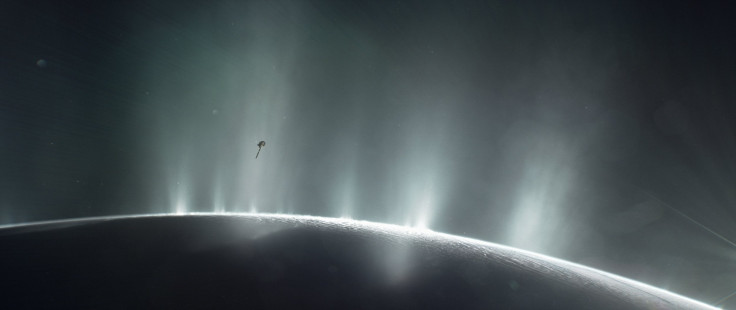Holographic Microscope Might Be Able To Detect Life On Icy Moons

A new research article out of California University of Technology suggests that holographic imaging could be the key to finding extraterrestrial life on Saturn’s moon, Enceladus, and others like it. The moon is covered in ice, but under that crust is a liquid ocean with geysers that release plumes of water vapor through the icy surface and into outer space around the moon.
The research, conducted by Jay Nadeau a research professor at the university, suggests using an adapted version of a digital holographic microscope to study the movement of possible microbes in the plumes. The digital holographic microscopy technique uses lasers to collect 3-D images of tiny little organisms.
Read: NASA New Discoveries: Saturn, Jupiter Moons May Be Able To Support Life
NASA announced in April that Saturn’s Enceladus and Jupiter’s Europa both have the potential to support simple life that requires no sunlight. Such organisms could draw energy from the hydrogen leaking into the oceans by combining it with carbon dioxide, a process called methanogenesis. The Cassini spacecraft discovered these plumes while conducting a deep dive around the moon in 2015, according to NASA. While the craft was able to determine some present elements it was unable to determine whether there were other key building blocks to life, or anything actually living. So now researchers are working to figure out what type of microscope would be best to send to one of these icy moons.
This new proposed research method would hopefully help identify whether there’s life, but would need to be added to crafts that will fly through the plumes in the future.The fact that the plumes are venting out into space makes studying them easier because crafts would only need to flyby rather than successfully land on the moons. But only part of the research could be done remotely, and the microscopes used for this technique on Earth would need to be adapted to work on a moving spacecraft in outer space conditions.
Capturing material with a flyby also presents its own challenges, some of which can be solved by using the holographic microscopy technique. The craft orbiting the moon would be traveling at an extremely high speed, which has the potential to pulverize any bacteria or microbes caught. So the craft would need to have some sort of decelerator, something Nadeau and her team are working on. Additionally the plumes aren’t thick, so crafts would have to make a minimum of 12 trips around the moons to gather enough material to actually study, Nadeau said in a video explaining the research.
Read: Can Planets Near Red Dwarf Stars Support Life? NASA Says Don't Bet On It
The method involves illuminating an object with a laser and the light that is reflected back is measured can give details on the amplitude and the intensity of the object that then allows a computer to reconstruct a 3-D image of the object, said a release from Cal Tech. Breaking down what the microbes are made of is possible as well but takes more work. The team plans to try and use this technique on remote parts of Earth before perfecting the method for potential space travel on a future NASA mission.
© Copyright IBTimes 2024. All rights reserved.











